The history of Monteverde from the 1950's to 2013
The History of Monteverde is an interesting tale! The information below is all about Monteverde's history, the Quakers, politics, education, the arts and much more:
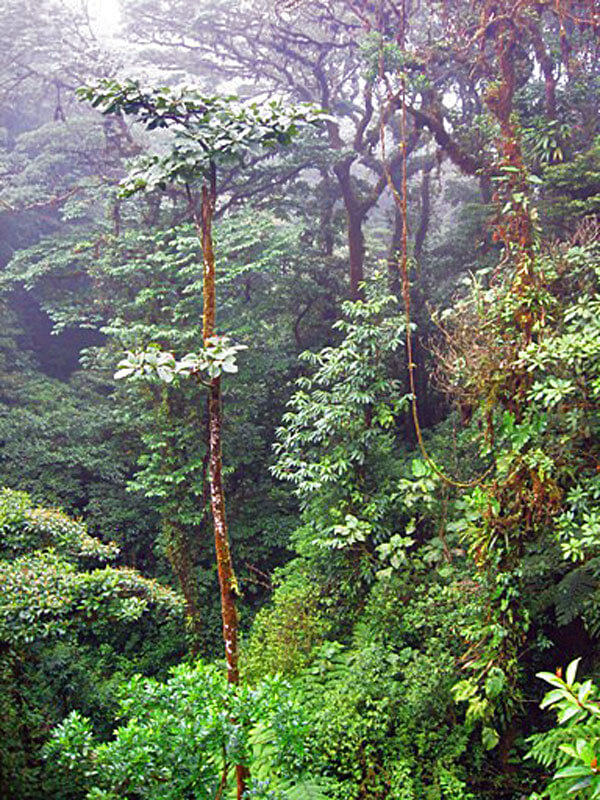
1. Introduction and the Settling of the Quakers in Monteverde
2. The Quaker’s Protection of the Forest
3. The Monteverde Friends School and Meeting House
4. Conservation, Research and Biodiversity of the Forests
5. The Founding of the Monteverde Cloud Forest Reserve
6. The Monteverde Conservation League
7. Wolf Guindon – Monteverde’s Best Known Conservationist
10. Local Politics and the Layout of Monteverde
11. The Monteverde Cheese Factory
13. The Arts and the Monteverde Music Festival
14. The Spirit of Monteverde and the Future
1. Introduction and the Settling of the Quakers in Monteverde
The community of Monteverde is located at 1400 meters (4600 ft) in the Tilarán Mountains of north central Costa Rica. It is about a three and half hour drive from either San José in the central valley or Liberia in the northwest. After the relatively straight fast trip along the Pan American Highway from either of these cities, visitors need to be prepared for a scenic drive up the mountain on the famous Monteverde road with its incredible views over the lowlands - and they are never disappointed that they came.
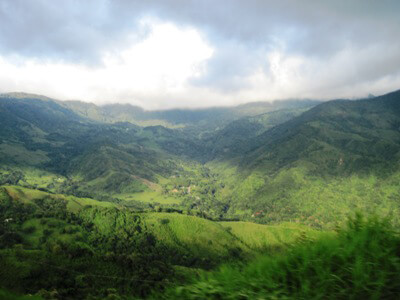
This lush cloud forest is a cool relief from the extreme heat of the Pacific coast beaches and a vibrant green alternative to the sun-dried flat lands of Guanacaste and Puntarenas. The undulating farmland of rich volcanic soils and a temperate climate is what attracted a group of Quakers from the United States here in 1951 (Quakers are also known as the Religious Society of Friends or, simply, Friends). Since their arrival, Monteverde has undergone many changes, but the Quaker principles of cooperation, pacifism and simplicity continue to influence life on the green mountain. (For more about Quakers see: http://www.quaker.org )
The Settling of the Quakers in Monteverde
In the late 1940s, uncomfortable with the growing military industry in the United States, the Meeting of Friends in Fairhope, Alabama decided that they could not remain in the US and pay their taxes toward the war effort. In 1949, four young men in the group were sentenced to a year in prison when, as conscientious objectors, they refused to register for the draft. They were released after four months and, upon completing their parole period, in November 1950 the group of forty-four Quakers, comprising eleven families, left their northern homes and came to Costa Rica. They chose this tiny Central American country largely for its farming potential and pleasant climate, but they had also read the words of Pepe Figueres, the Costa Rican president at the time, inviting foreigners to come and help develop this country. Perhaps most attractive for the Friends though was the fact that Costa Rica had just abolished its own army and these pacifists felt they could live in peace here.
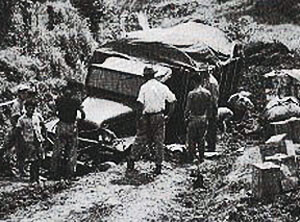
We do not feel that our gesture in coming here was a striking blow against war or that, in itself, will it have any great effect toward bringing universal peace among men. But every wave on the ocean has its beginning in a tiny ripple somewhere, and perhaps our action will be that ripple which starts others to thinking and acting so that eventually the wave of public opinion will attain the desired end. Arthur Rockwell, founding member of the community
For six months, the Quakers lived near San Jose and searched throughout Costa Rica for a suitable spot to establish their community. They were finally introduced to this parcel of land straddling the Continental Divide where a few Costa Rican (tico) families were homesteading. The group bought 1400 hectares (about 3500 acres), situated above the tiny communities of Santa Elena and Cerro Plano, from the Guacimal Land Company and the local ticos, many of whom simply moved to other properties nearby. The Quakers divided the land into individual family farms, keeping a large piece for common purposes such as their school and Meeting House as well as what was to be their first attempt at a sustainable business, the Monteverde Cheese Plant. Many of these Quakers were not farmers back in Fairhope, so this was a great adventure in pioneering, clearing land, learning about dairy farming and the business of making cheese.
2. The Quaker’s Protection of the Forest
Being pragmatic country folk, the Quakers decided to protect the forest on the steep slopes at the top of the mountain from where the streams flowed, providing the water the community relied on for all aspects of their lives. They placed about a third of the land, 554 hectares (1300 acres), in a reserve they called The Watershed Property and cared for it together, keeping the boundary lines cut and evicting illegal squatters before they cut trees or made a claim. This would be one of the very first private reserves in Costa Rica.
Though the Quakers enthusiastically cut trees to make pastures on their own farms, they agreed not to cut the forest in the Watershed Property, understanding the importance of protecting the headwaters of the Guacimal River. These days, when driving through the lowlands below Monteverde in the dry season (February through April), the Guacimal River is often the only river still flowing – the high demands for water, deforestation, and a much hotter, dryer climate has meant that most of the other rivers go dry until the rains start again in May. 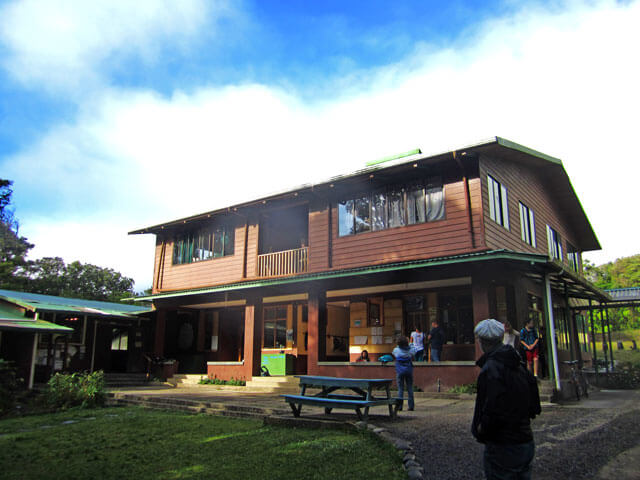
3. The Monteverde Friends School
Upon their arrival on the mountain, the Quakers started the Monteverde Friends School where children continue to be taught in an atmosphere that supports Quaker values. The school operates on the principle that spiritual development is as important as physical and intellectual development. They strive to lay a foundation of solid intellect, the pursuit of truth, and the values necessary to contribute to a peaceful and just society. In the beginning, the Friends School was attended by the English-speaking mostly blonde blue-eyed offspring of the Quaker families in classes from kinder through high school. Now with an enrollment of over 100 students, you will find a majority of the children are from Costa Rican families who, along with exchange students and children from North America, Europe and Latin America, continue to learn together in a bilingual environment that still espouses a cooperative and creative model of education.
The Friends Meeting House
The Friends School building was constructed in 1957 and the Friends Meeting House in the early 1960s, both under the care of the Monteverde Friends Meeting. Over the years, the buildings have expanded to meet the growing population. In 2011, the soccer field was leveled and resurfaced, and in 2013, needing to replace the original Meeting House, a beautiful new timber-frame building went up, funded and built mostly by volunteers in an incredible show of community spirit and teamwork. Check out the facebook page of the Timber Framing Project to see photos and building progress (or get involved!). https://www.facebook.com/NewMeetingHouseMonteverdeFriends 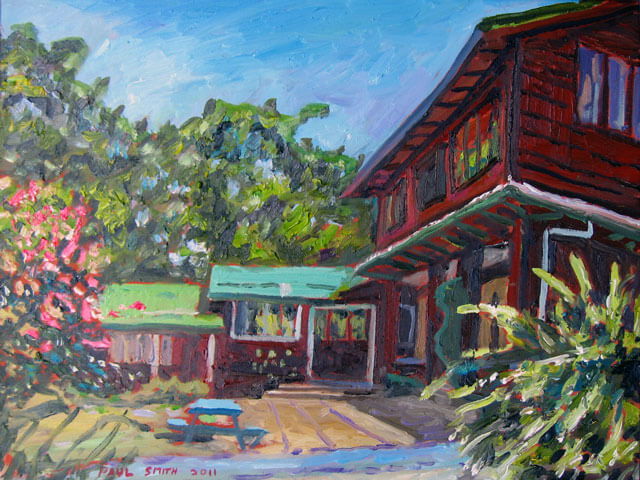
Painting done by Paul Smith in 2011, paintings like this one for sale by auction to raise money. The Monteverde Friends School and Monteverde Friends United States joined together to raise $60,000 for financial aid for kindergartener. See http://www.monteverde60th.org/
There are often community events – coffee houses, concerts, sports days - held at the school and Meeting House, many of which are open to visitors. Tourists are also welcome to attend the silent meetings, held on Wednesdays at 9 a.m. and Sundays at 10:30 a.m. Worship consists of an hour of meditation when participants quietly commune with the Divine spirit until someone is moved by the Spirit to speak. There is no minister or preacher. The hour of silence is followed by introductions and announcements, a valuable time for welcoming visitors and sharing community news.
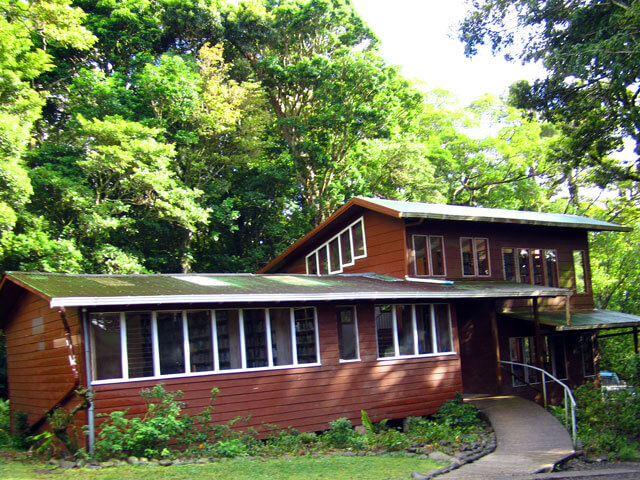
A visit to the heart of the Quaker community is one of the unique activities in this area and something that will give visitors a better appreciation of this charming community. More information about the school and Meeting can be found at http://mfschool.org
Next to the school building, opposite the Meeting House, is the Monteverde Libarary which is open to the whole community.
4. Conservation, Research and Biodiversity of the Forests
During their first ten years on the green mountain, the Quakers cleared land, built homes, raised children, milked cows, and developed the dairy plant. In the 1960s, biologists started visiting Monteverde, drawn by the English-speaking population, the friendly and peaceful Costa Rican society, and the vast natural biodiversity. It was during these years that the most famous amphibian on the mountain, the Golden Toad, was first reported on by biologists. At the same time, bird watchers began flocking to Monteverde in search of the famous Resplendent Quetzal, Three-wattled Bellbird, and other exotic creatures.
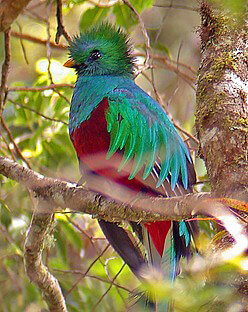
It was with the arrival in 1970 of George and Harriett Powell, biology graduate students from California, that the relatively new concept of conservation was introduced. They came to Monteverde to work on George’s doctorate research and rented a small cabin on the farm of Wolf and Lucky Guindon. Wolf and Lucky had arrived with the original Quakers in 1951 when they were just twenty and eighteen years old, a month after being married in Fairhope. Wolf was a keen walker and an enthusiastic explorer of the surrounding forest. He was one of the few experienced dairy farmers in the group and became the first chain saw dealer in Costa Rica, importing the machines to speed up the cutting of trees creating new pastures for the growing dairy herds.
When the Powells realized how quickly the forest was disappearing, and recognizing that there was a wealth of species within that forest that would disappear before even being identified, they decided they had to do something to slow down the deforestation. They started to raise money from their family, friends and colleagues back in the US with the intention of buying the primary forest before the locals could cut it down. They hired Wolf Guindon, who knew this forest and most of the homesteaders scattered throughout the remote ridges and valleys, to help them find the owners of desirable parcels of land, to negotiate with them to purchase the land, to cut the boundary lines and keep the trails connecting the parcels open.
5. The Founding of the Monteverde Cloud Forest Reserve
The Powells also negotiated with a scientific research organization in San José, the Tropical Science Center, to handle the funds they raised and to care for the land. In 1972, the Monteverde Cloud Forest Biological Preserve (commonly known as the Monteverde Reserve) was founded, encompassing 328 hectares (810 acres). The World Wildlife Fund in the US donated money for administrative and vigilance costs over the next three years and more money was raised and more properties were bought.
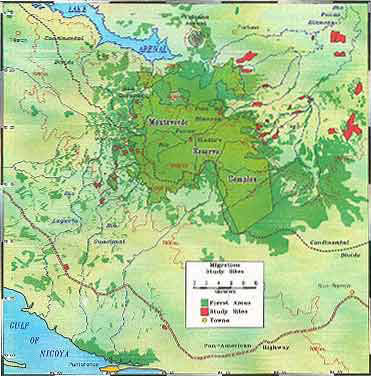
In 1974, the Quaker community, who had been caring for their Watershed Property for the last twenty years, incorporated their land and named it Bosqueterno S.A. (The Eternal Forest). They agreed to lease the land to the Tropical Science Center as part of the Monteverde Reserve, which would be responsible for the administration and maintenance of it, but the shareholders of BESA would continue to oversee its well-being. Once done, this agreement brought the total amount of land under protection in the Monteverde area to about 2000 hectares (around 4940 acres) and took the community of Monteverde further down the path of conservation and habitat protection.
George and Harriett Powell returned to the United States, leaving Wolf Guindon, his son Tomás, and a young, quietly intelligent Costa Rican from neighboring San Luis, Eladio Cruz, to continue the work of finding properties, negotiating purchases, protecting plants and animals from poachers, maintaining boundary lines and trails, and spreading the word of conservation throughout the area. More land in the Peñas Blancas River valley, which is on the eastern side of the Continental Divide, and land on the upper slopes surrounding Monteverde was added to the Cloud Forest Reserve. In 2013, the reserve comprises more than 10,500 hectares (26,000 acres) and continues to protect mostly virgin forest.
6. The Monteverde Conservation League
In the mid-1980s, local landowners and resident biologists gathered together to discuss their concern about lands that were outside of this area, hillsides still being deforested by cutting or burning, affecting soil retention, water quantity and quality, and threatening whole ecosystems. In 1985, the Monteverde Conservation League was founded by these concerned residents. Their focus was to raise funds to purchase forested land to be protected, but they also developed programs on reforestation and environmental education. They bought properties further down the Peñas Blancas River valley in the region of San Carlos and started a tree nursery in the Monteverde area, growing tree seedlings to aid in reforestation of windbreaks and small tree lots on the Pacific slope.
.jpg)
In 1987, Sharon Kinsmen, a biologist who knew Monteverde well, went to Sweden and gave slide show presentations to public school students. The sharing of stories and images of the forests of Costa Rica inspired the young students to raise money to send to the Monteverde Conservation League to help protect the remaining wilderness. Over the next four years, through a series of fundraising bake sales and other events, the school children of Sweden raised close to one million dollars to help in the protection of Monteverde’s forests. This amount was matched by the Swedish government and by the early 1990s close to two million dollars was donated to the Conservation League. An amazing result from brownie sales! Money also came from elsewhere in the world thanks to the fundraising efforts of several organizations concerned with the survival of the tropical rain and cloud forests.

Close to 20,000 hectares (45,000 acres) of land was purchased by the Conservation League. In 1988 the land was designated the Children’s Eternal Rain Forest (or BEN – Bosque Eterno de los Niños) and it is still the largest private reserve in Central America (now roughly 22,500 hectares or 54,000 acres). The League expanded to having an office in San José de La Tigre in San Carlos and hired a number of forest guards to help protect this large area from hunters, tree cutters, squatters, and palm tree poachers (the heart of palm, or palmito as it is known here, is a traditional Easter food, but in the wild the whole tree is cut just to harvest the heart resulting in the destruction of many trees.)
7. Wolf Guindon – Monteverde’s Best Known Conservationist
Wolf Guindon, the Quaker who became the leading conservationist in the Cloud Forest Reserve, also worked as Head of Vigilance for the Conservation League, patrolling throughout this large remote area, across the many ridges, up and down the streams, keeping threats to the forest at bay and sharing his deep commitment to conservation with anyone who would listen. One of the most powerful influences Wolf had on the forest guards of both the Monteverde Reserve and the Conservation League was that, as a Quaker, he refused to carry a gun.
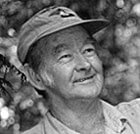
When faced with an adversarial situation, often alone in isolated areas confronting men who were carrying guns or chainsaws or machetes, he proceeded by treating them with respect, appealing to the side of them that was God-loving and well-meaning, and he disarmed them with humor. He taught the young Costa Rican forest guards this approach to conflict resolution and to this day, the guards of the Reserve and the League do not carry guns, unlike most conservation officers in North America and elsewhere in protected zones in Costa Rica.
You can read more of the fascinating history of Monteverde through the unique and often amusing stories of Wolf Guindon in a book, Walking with Wolf: Reflections on a life protecting the Costa Rican wilderness, 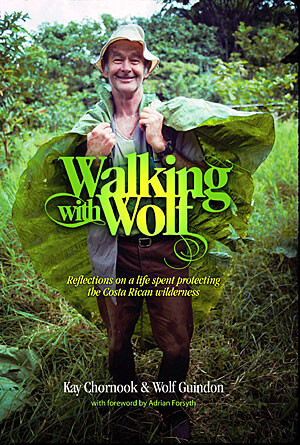 , a Canadian living for many years in Monteverde. The book is available in many stores in Monteverde or online through Kay’s blog at: http://walkingwithwolf.wordpress.com
, a Canadian living for many years in Monteverde. The book is available in many stores in Monteverde or online through Kay’s blog at: http://walkingwithwolf.wordpress.com
It was also in the 1980s that tourism started to take off in Costa Rica and especially in Monteverde. With the mix of the friendly ticos and English-speaking ex-pats, the unique Quaker community, the relatively accessible cloud forest (once you had made it up the road), the wealth and diversity of birds, orchids, trees, insects, and butterflies, that alone the never-ending rainbows and magical moonbows, there is an endless supply of natural beauty and interesting people to keep a visitor intrigued.
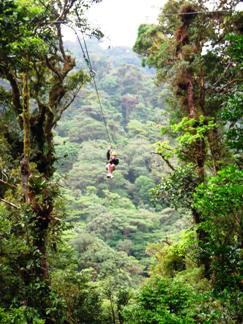
The number of good quality hotels and restaurants started to grow and it was here in Monteverde in the early 1990s that the Original Canopy Tour was created. Now there are zip lines and suspension bridges throughout Costa Rica and here in Monteverde there are several companies catering to extreme sports, including bungee jumping, rappelling down waterfalls, horse-backing trekking, and mountain biking, as well as some of the best long distance hiking trails in Central America.
For those who live here, there is a distinction between the communities of Monteverde, Cerro Plano and Santa Elena, but for visitors it is hard to know the difference. All the main roads arrive in the bustling downtown of Santa Elena, the business center of the area. If you come in from La Fortuna and Volcano Arenal, you can arrive by the jeep/boat/jeep option across Lake Arenal or take the scenic drive around the lake to Tilarán. You will pass through the many small communities, coffee plantations and dairy farms that supply the Monteverde Cheese Factory before arriving in Santa Elena.
Coming from Liberia, there is a road leaving the Pan American Highway and passing through Las Juntas, an old gold mining town where the early Quakers had to go on horseback for their supplies. This road can be quite rough (all the roads are) but is shorter than the alternative which is continuing south on the highway to the main entrance off the highway at Sardinal. Now the most traveled route to Monteverde, this road is paved for the first several miles to Guacimal and so the time has been cut significantly in getting up the mountain with only about forty-five minutes driving on gravel.

The controversy continues over whether or not to finish paving the road. In the past there was a lot of opposition to this by the conservationists in Monteverde, not only concerned about the negative impacts of impervious road surfaces, but also preferring to encourage a type of tourism where people come and stay for a few days in the community rather than just pass through. Now there is a major health issue of too much dust from the increased traffic in the long dry season affecting the lungs of those who live next to the road and laying a thick coat of dust on the plants that border the road. In 2013 there has been another promise made by the government that they will be paving the road and it is hard to stop progress, even when it comes very slowly.
Update! As of June 2013, the government has promised that the road will be built starting November 2013.
10. Local Politics and the Layout of Monteverde
In 2003 the District of Monteverde, within the Province of Puntarenas, was created with a local governance, locally known as the Muni that oversees planning and development in an area that encompasses Santa Elena, Cerro Plano and Monteverde as well as the neighboring villages of Los Llanos, Lindora and San Luis. It covers 53 square kilometers (20 square miles) and has a population of 5500 people. The majority of Costa Rican families live in Santa Elena and Cerro Plano where the roads have been paved for several years. There is also the larger umbrella designation, the Monteverde Zone, which crosses political boundaries, and refers more generally to the region covering businesses related to Monteverde tourism. You can still be far from the actual community when you start seeing signs for Monteverde attractions and hotels.
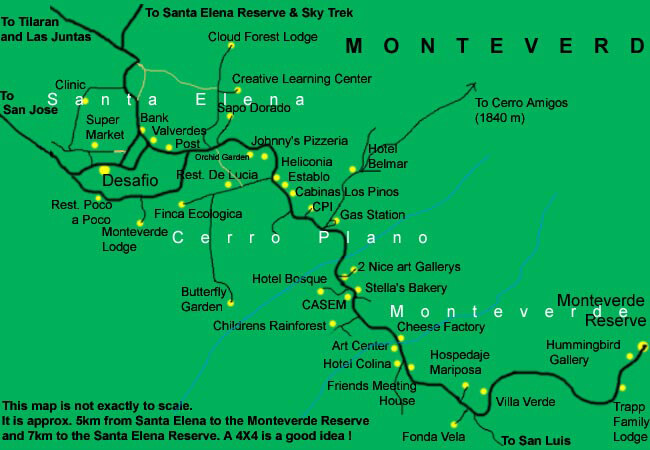 The original Quaker community of Monteverde begins about two kilometers outside of Santa Elena, up the road beyond where the pavement ends, and continuing until the road ends at the Monteverde Cloud Forest Reserve. There has been a lot of development in the area but it tends to drop off noticeably when you get beyond the asphalt. Housing barrios are replaced by green pastures and farmhouses that are reminiscent of the eastern United States. The Monteverde Monthly Meeting oversees the Friends School and Meeting, but also meets regularly to discuss issues pertaining to the whole community. Once the more formal District was incorporated, the original Monteverde Town Meeting, that had overseen services, roads and community issues, was disbanded. Now utilities and infrastructure concerns are dealt with by the government ministries who are supposed to be accountable and by the Muni.
The original Quaker community of Monteverde begins about two kilometers outside of Santa Elena, up the road beyond where the pavement ends, and continuing until the road ends at the Monteverde Cloud Forest Reserve. There has been a lot of development in the area but it tends to drop off noticeably when you get beyond the asphalt. Housing barrios are replaced by green pastures and farmhouses that are reminiscent of the eastern United States. The Monteverde Monthly Meeting oversees the Friends School and Meeting, but also meets regularly to discuss issues pertaining to the whole community. Once the more formal District was incorporated, the original Monteverde Town Meeting, that had overseen services, roads and community issues, was disbanded. Now utilities and infrastructure concerns are dealt with by the government ministries who are supposed to be accountable and by the Muni.
11. The Monteverde Cheese Factory
Once you hit the gravel, the road will soon bring you to the Monteverde Cheese Plant, or the lecheria, which has grown over the years into a very successful business producing a large variety of prize-winning cheeses and still selling fresh milk. In the 1990s, in an effort to overcome effluent problems with run off of the operation into the nearby stream, the company developed a pig farm down river, with holding ponds that filters the stream water. It was always a controversial move that caused some people to leave the community, but has resulted in an array of pork products – bacon, sausages and processed meats – being available. The factory also expanded into yoghurts and a large selection of delicious ice cream. You can take a tour of the cheese plant and shop for their products (fig ice cream anyone?!) in their store. For more information click here.
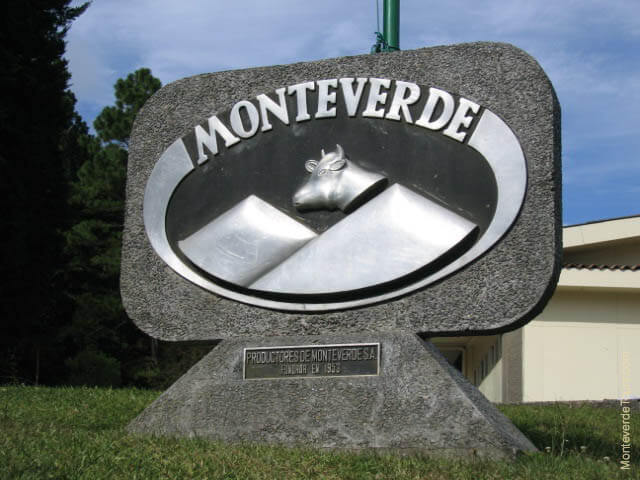
The Monteverde Cheese Plant was started by the original families of Quakers who had to learn everything from proper milking techniques, to the safe storage and processing of milk, to the fine art of making cheese. Once the Quakers got established, they invited local Costa Rican dairy farmers to become part of the business. Eventually the plant had many more milk suppliers and employees who were ticos than Quakers. In 2013, the locally-owned and operated company was sold to a large Mexican food corporation, Sigma, and now the future of this successful sixty-year old Monteverde business is uncertain.
Not far from the cheese plant is the Monteverde Friends School, but there are a number of other schools in the area. In Cerro Plano are the small private Adventist School and the larger Creative Learning Center. The CLC, founded in 1991, has classes from kinder through grade 11 held on a large campus set in the forest above Cerro Plano with an enrollment of around two hundred students.
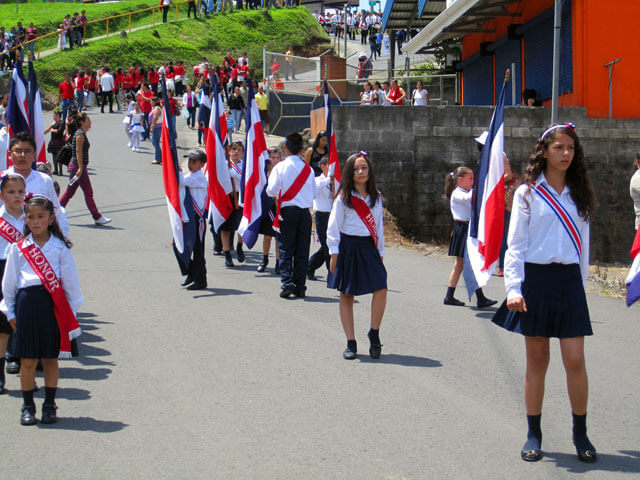 There are a number of public schools in the area and a public high school in Santa Elena. Monteverde also hosts several university programs in biology, tropical conservation and sustainability. The Monteverde Institute, located next door to the cheese plant, facilitates both long and short term courses in collaboration with secondary and post-secondary institutions in the United States. There are semester courses with the Education Abroad Program (EAP), the Council on International Educational Exchange (CIEE), and the University of Georgia has a satellite campus in San Luis. Hundreds of students benefit each year from these credited courses which also offer homestays, Spanish classes and cultural awareness. For more information on the activities of the Monteverde Institute see: http://monteverde-institute.org
There are a number of public schools in the area and a public high school in Santa Elena. Monteverde also hosts several university programs in biology, tropical conservation and sustainability. The Monteverde Institute, located next door to the cheese plant, facilitates both long and short term courses in collaboration with secondary and post-secondary institutions in the United States. There are semester courses with the Education Abroad Program (EAP), the Council on International Educational Exchange (CIEE), and the University of Georgia has a satellite campus in San Luis. Hundreds of students benefit each year from these credited courses which also offer homestays, Spanish classes and cultural awareness. For more information on the activities of the Monteverde Institute see: http://monteverde-institute.org
Another very important aspect of life in Monteverde is the support for and love of the arts – music, visual arts, theatre, dance, and storytelling. The Quakers always knew how to entertain themselves since they came to this remote place without movie theatres or cultural centers and many of them to this day don’t have televisions. They originally held regular family nights where one of the families would be responsible for the program, whether it would be songs or skits, and everyone took turns and joined in. These later became coffee houses – amateur talent nights filled with much hilarity and enjoyment – and sometimes even a remarkable performance.
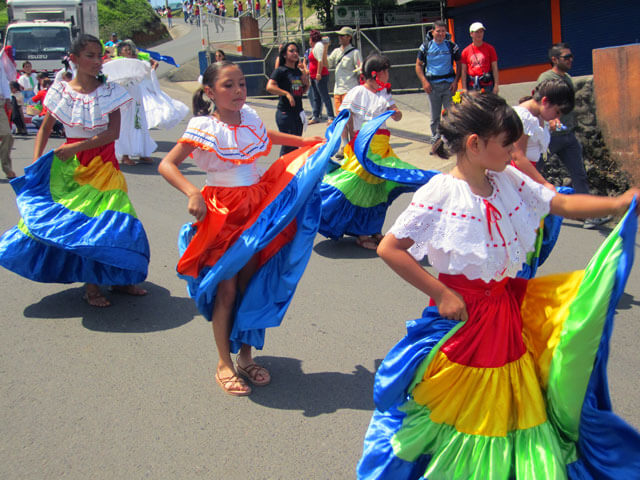
Dancing has always been part of the Costa Rican way of life, from tradional folk dances to fast salsa. In Monteverde there is also square dancing, not what you would typically expect to find in Costa Rica!
Square dances have been held here since the 1950s. The first accompaniment was on harmonicas, then someone got an accordion, then the local ticos brought guitars and eventually someone provided an old record player and scratchy records. The Guindon family has always provided the callers for the dances and many ticos learned to dance alongside the Quakers. Bit by bit more instruments arrived in the community. There were teachers at the school who taught music and art and theatre. Big community productions of plays and then musicals were put on, with everyone participating, whether building and painting scenery, sewing costumes or singing in the chorus.
The Monteverde Music Festival
In the early 1990s, the Monteverde Music Festival was created, originally as a series of classical music concerts that over the years expanded to include all genres of music. First held in a private home with a spectacular view, the Villa, the festival then moved to the Fonda Vela Hotel, later to the Monteverde Institute, then to the stunning Bromelias Amphitheatre. The festival has changed direction, directors and venues over the years, but it always attracts excellent national and sometimes international musicians, and is enjoyed by locals and tourists alike. In 2013, the festival was held in the relatively new Centro Commercial in Santa Elena, moving it out of the more natural settings but making it accessible to a bigger local population. Many community members have worked hard over the years on the Monteverde Music Festival that has brought an incredibly high quality of music to this little mountain community.
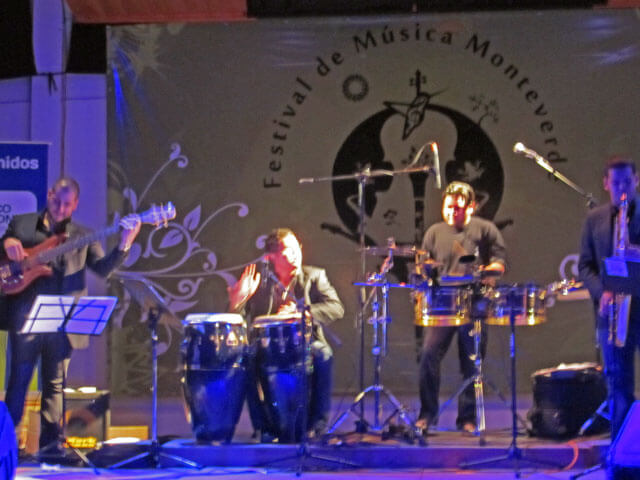
The truth is that at any time of the year you can enjoy great music here in any number of venues – be it local bands, individual performers, national musicians or international talent who are happy to have the opportunity to share their abilities with Monteverde’s appreciative audiences. You can join in with the square dancing or English contra dances on Saturday nights at the Friends Meeting House, or head to one of the bars and dance to salsa, reggae or rock. You can visit any of the excellent galleries of very talented artists and craftspeople from the community, some involving glorious walks in the woods to get there. There are artists creating jewelry, ceramics, wooden pieces, paintings and textile arts. The co-operative CASEM, located in the central part of Monteverde, was established in the 1980s as a project to give local women a way to earn money and continues to this day as a showroom of the region’s craftspeople.
14. The Spirit of Monteverde and the Future
From its early pioneering days, Monteverde has grown with a spirit of collaboration and cooperation. The community has always been receptive to new ideas, embracing the knowledge that arrived with the scientific community and working together to deal with the changes that come with development and tourism. Conservation here grew beyond the borders of the Monteverde Cloud Forest Reserve and the Children’s Eternal Rainforest to the Santa Elena Reserve, the Curi Cancha Wildlife Refuge, La Calandria Reserve, and a number of other private reserves and sanctuaries.
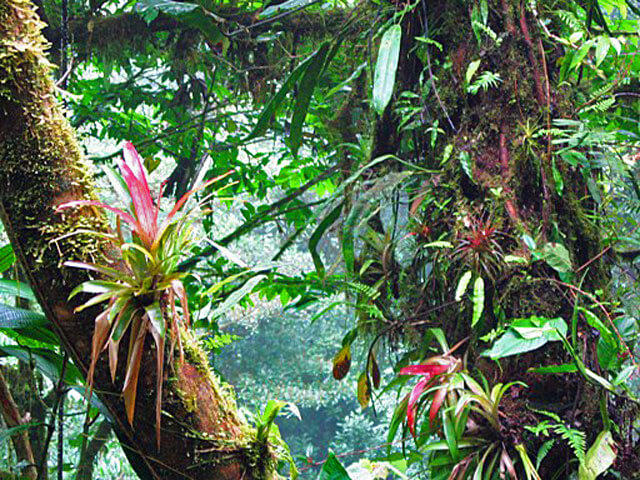
Protected wilderness areas often exist as islands in a sea of deforested land. The challenge is to connect these protected areas over a large region to help ensure the future of those bird species which need to migrate great distances at various elevations and need certain tree species to complete their feeding and nesting cycles. The larger mammals such as the jaguar, puma and tapir also need significant tracts of wilderness if they are to survive. In recent years, many local organizations have joined together in a project called the Bellbird Biological Corridor, reforesting and connecting the patchwork of forests on the Pacific slope from the Continental Divide in Monteverde to the Gulf of Nicoya at sea level. The Costa Rican Conservation Foundation, another local initiative that maintains a tree nursery and works on reforestation projects, is dedicated to the future of this natural corridor, where the continuing sound of the bellbirds’ distinct BONK means that they are achieving some success.
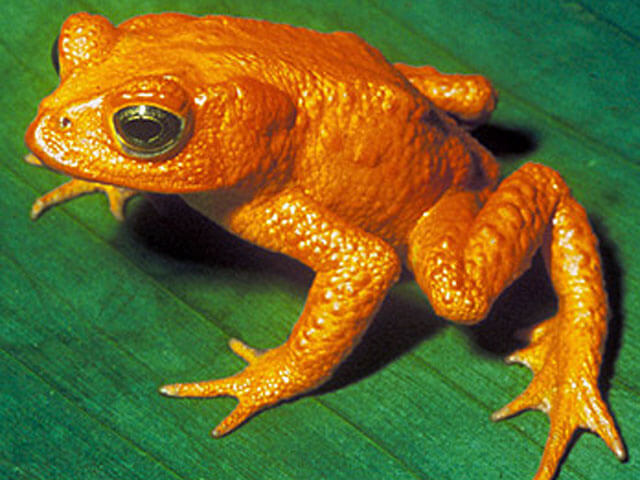 The people of Monteverde are blessed with living in one of the most bio-diverse environments on the planet and visitors quickly discover just how extraordinary this place is. The presence of our beautiful feathered friends such as the quetzal, hummingbirds, and motmots, as well as jaguars and other mammals, cannot be taken for granted. The early poster child of the conservation movement, the Golden Toad, disappeared in 1989 before studies could be done to understand how it lived, that alone what caused its demise. There are still people searching the forest with the hopes that one or two of those colorful toads have survived while many more people keep working hard to see that other species don’t disappear. It is with the help of tourist dollars that the local reserves and organizations can continue to do the important work of saving natural habitats and maintaining species populations. Tourism also provides the livelihood of the majority of the residents of Monteverde. It is the past, the present and the future of life on the green mountain – and visitors are always welcome.
The people of Monteverde are blessed with living in one of the most bio-diverse environments on the planet and visitors quickly discover just how extraordinary this place is. The presence of our beautiful feathered friends such as the quetzal, hummingbirds, and motmots, as well as jaguars and other mammals, cannot be taken for granted. The early poster child of the conservation movement, the Golden Toad, disappeared in 1989 before studies could be done to understand how it lived, that alone what caused its demise. There are still people searching the forest with the hopes that one or two of those colorful toads have survived while many more people keep working hard to see that other species don’t disappear. It is with the help of tourist dollars that the local reserves and organizations can continue to do the important work of saving natural habitats and maintaining species populations. Tourism also provides the livelihood of the majority of the residents of Monteverde. It is the past, the present and the future of life on the green mountain – and visitors are always welcome.
For you are interested in doing a guided walk of the Monteverde forest and learning about its history click here for details